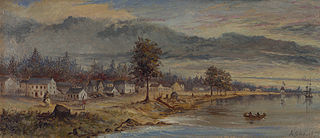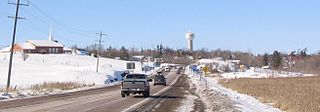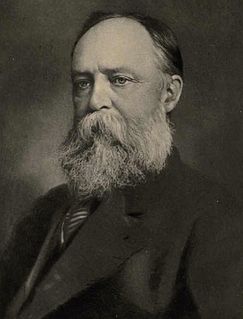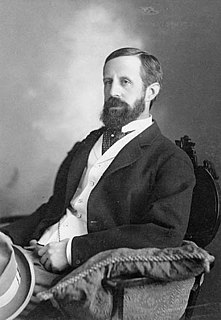
Amelia Opie was an English author who published numerous novels in the Romantic period up to 1828. Opie was also a leading abolitionist in Norwich, England. Hers was the first of 187,000 names presented to the British Parliament on a petition from women to stop slavery.

York was a town and second capital of the colony of Upper Canada. It is the predecessor to the old city of Toronto (1834–1998). It was established in 1793 by Lieutenant-Governor John Graves Simcoe as a "temporary" location for the capital of Upper Canada, while he made plans to build a capital near today's London, Ontario. Simcoe renamed the location York after Prince Frederick, Duke of York and Albany, George III's second son. Simcoe gave up his plan to build a capital at London, and York became the permanent capital of Upper Canada on February 1, 1796. That year Simcoe returned to Britain and was temporarily replaced by Peter Russell.

Whitewater Region is a township on the Ottawa River in Renfrew County, located within the scenic Ottawa Valley in eastern Ontario, Canada. Whitewater Region is made up of the former municipalities of Beachburg, Cobden, Ross and Westmeath, which were amalgamated into the current township on January 1, 2001.

The Bytown Museum is a museum in Ottawa located in the Colonel By Valley at the Ottawa Locks of the Rideau Canal at the Ottawa River, just below Parliament Hill. Housed in the Commissariat Building, Ottawa's oldest remaining stone building, the museum provides a comprehensive overview of the origins of Bytown and its development and growth into the present city of Ottawa.
William Robertson was a businessman and political figure in Upper Canada.

Sir Byron Edmund Walker, CVO was a Canadian banker. He was the president of the Canadian Bank of Commerce from 1907 to 1924, and a generous patron of the arts, helping to found and nurture many of Canada's cultural and educational institutions, including the University of Toronto, National Gallery of Canada, the Champlain Society, Appleby College, Art Gallery of Ontario and Royal Ontario Museum.
Port Ryerse is a fishing hamlet in Norfolk County, Ontario, Canada, southwest of Port Dover. The hamlet is popular with persons from Southwestern Ontario who rent cottages and fish for pleasure during the summer months.

St. Paul's Church is an evangelical Anglican church in downtown Halifax, Nova Scotia, within the Diocese of Nova Scotia and Prince Edward Island of the Anglican Church of Canada. It is located at the south end of the Grand Parade, an open square in downtown Halifax with Halifax City Hall at the northern end.
James Lesslie was an Ontario bookseller, reform politician and newspaper publisher. His career was closely associated with - and somewhat overshadowed by - William Lyon Mackenzie, the Reform agitator, mayor of Toronto, and Rebellion leader. However, as a leader himself, Lesslie took a prominent role in founding the Mechanics Institute, the House of Refuge & Industry, the Bank of the People, as well as the political parties known as the Canadian Alliance Society and Clear Grits. In many way, he defined the Reform movement in Upper Canada without having reverted to the violent methods of Mackenzie. His legacy may thus have lasted longer.

Lieutenant-Colonel Robert Harris Carnwath Dalzell, 11th Earl of Carnwath was a Scottish hereditary peer and soldier.
Ronald Arthur Dalzell, 12th Earl of Carnwath,, was the second but only surviving son of Robert Dalzell, 11th Earl of Carnwath.
Brigadier-General Arthur Edward Dalzell, 13th Earl of Carnwath, CB was a British Army officer and a Representative Peer of Scotland.

Admiral Henry Wolsey Bayfield was a British naval officer and surveyor.

Canadian art refers to the visual as well as plastic arts originating from the geographical area of contemporary Canada. Art in Canada is marked by thousands of years of habitation by Indigenous peoples followed by waves of immigration which included artists of European origins and subsequently by artists with heritage from countries all around the world. The nature of Canadian art reflects these diverse origins, as artists have taken their traditions and adapted these influences to reflect the reality of their lives in Canada.

John Campbell Hamilton-Gordon, 1st Marquess of Aberdeen and Temair,, known as The 7th Earl of Aberdeen from 1870 to 1916, was a British politician. Born in Edinburgh, Lord Aberdeen held office in several countries, serving twice as Lord Lieutenant of Ireland and serving from 1893 to 1898 as Governor General of Canada.
Francis Wolferstan Thomas was a Canadian banker and a philanthropist in Montreal.

Hamilton Thomas Carlton Plantagenet MacCarthy was one of the earliest masters of monumental bronze sculpture in Canada. He is known for his historical sculptures, in particular his Pierre Dugua, Sieur de Mons at Annapolis Royal, Nova Scotia (1904) as well as Samuel de Champlain overlooking Parliament Hill on Nepean Point, Ottawa (1915), next to the National Gallery of Canada. His monument to the Ottawa volunteers who died in the South African War (1902) was moved to Confederation Park in 1969 after several moves. Other works include that of Ottawa mayor, Samuel Bingham, in Notre-Dame Cemetery in Vanier.

Robert Graves (1798–1873) was a British engraver.
Colonel Robert Alexander George Dalzell, CB was a British aristocrat and soldier.
Hugh Ronalds was an esteemed nurseryman and horticulturalist in Brentford, who published Pyrus Malus Brentfordiensis: or, a Concise Description of Selected Apples (1831). His plants were some of the first European species to be shipped to Australia when the British colony was founded.











